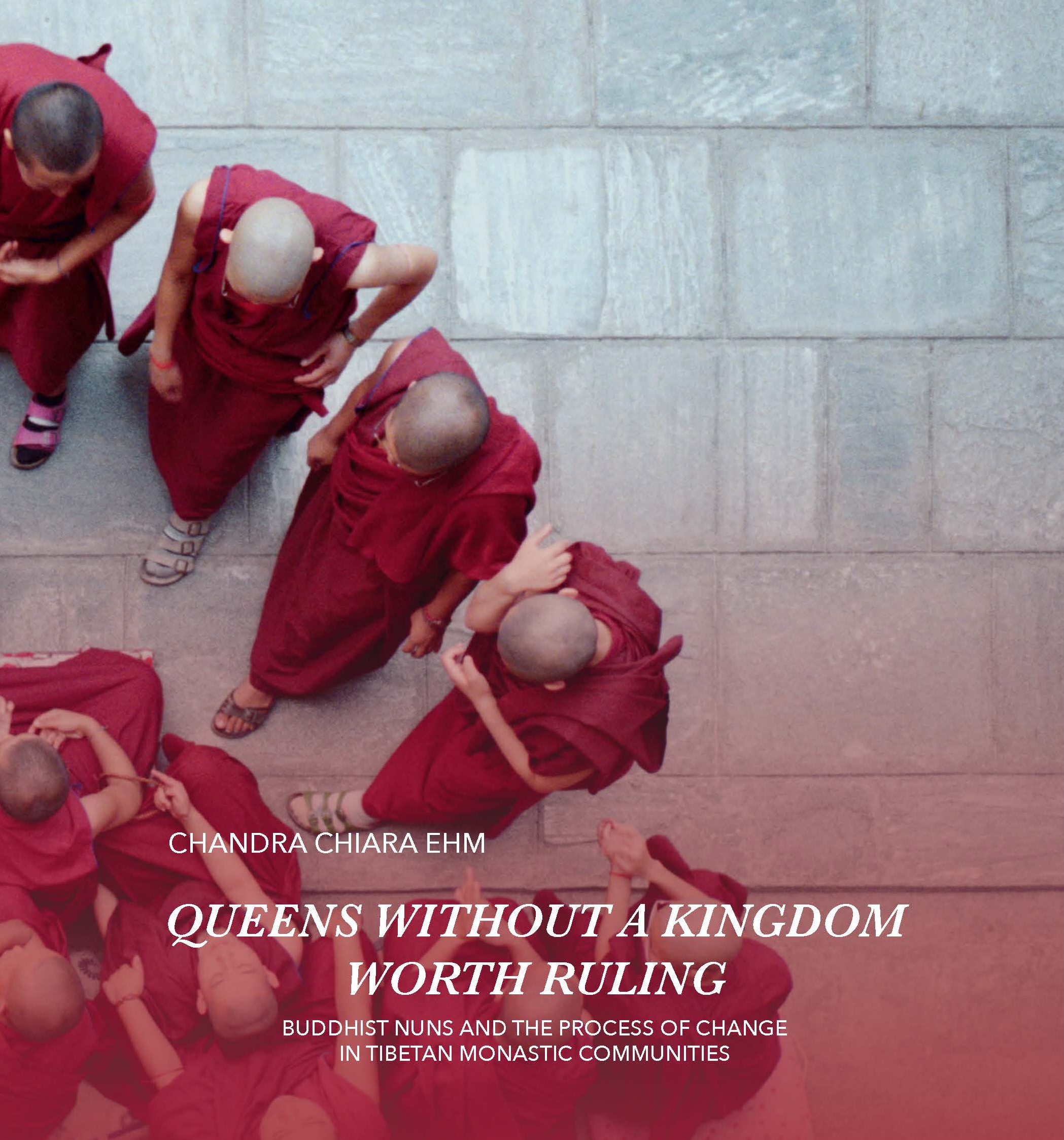It was late afternoon when I entered the dimly lit temple (lha khang) of Khachoe Ghakyil Ling nunnery (mKha’ spyod dga’ ’khyil gling; Pure Land of Celestial Enjoyment) in Kathmandu. The room was filled with the strong fragrance of freshly burned myrrh. Statues of buddhas and meditation deities were gleaming on the altar, and the hall was bursting with 400 women, all dressed in wine-red winter cloaks (zla gam). In a high pitch of excitement punctuated by the clapping of hands, a typical feature of Tibetan debates, the nuns were busy following philosophical arguments as they traveled back and forth between two groups representing opposing views. The debate had started with some of the nuns sketching out plain outlines, which they then elaborated upon by citing Indian root verses and their commentaries, supplemented with independent, sharp logic that sought to disprove the other side’s stance: a tradition in these contests of logical skill, which date back to the time when Buddhist philosophy flourished at Nalanda University (see Dutt 1962). Suddenly, a crowd of young nuns rushed in with teapots full of fresh butter tea (bod ja), interrupting the animated proceedings. The line of argumentation was soon resumed, now amidst an audience calmly slurping their refreshment.
This inspiring scene unfolded during my first sojourn in China and Tibet in early autumn 2007. It was due to this experience that I decided to spend some time with the Tibetan nuns at Khachoe Ghakyil Ling nunnery in the hope of getting to know them better. Khachoe Ghakyil Ling is the sister nunnery of Ogmin Jangchub Choling (dPal’og min byang chub chos gling), which is more commonly known as Kopan monastery. At the time, I was not aware that I had been witnessing the yearly debate exams and thus some of the most energized moments in the nunnery’s calendar. I remember, though, the fascination and sense of connection I felt upon my first sight of these religious women. As a young traveler in my late teens, I found the appeal of the nuns’ maroon robes, their glowing, distinctive facial expressions and the way they wielded a language I had always been familiar with but still did not understand truly captivating. At that point, seeing them as shining beacons of hope and proud religious queens, I could only imagine them to be the rulers of their own religious queendom. I was sure that I saw before me a community of young nuns who were perfectly autonomous and capable of confidently articulating their philosophical knowledge to an audience of both monks and nuns: a feminine realm, portraying to an outsider like me a reality of self-sufficiency, independence and community strength based on scholastic erudition.
“As a young traveler in my late teens, I found the appeal of the nuns’ maroon robes, their glowing, distinctive facial expressions, and the way they wielded a language I had always been familiar with but still did not understand truly captivating.“
Looking back, a strong fascination with the stability and depth that monastic institutions appear to offer must be something that strikes most of us who choose to entrust ourselves to a religious institution and pursue an inner path towards the Buddhist goal of enlightenment. For me, this allure did, in part, spark my decision to relinquish outer control and retreat to the nunnery, where I would rely on a religious framework to follow my self-appointed calling to find inner control and fulfillment. This was supplemented by my wish to study Tibetan Buddhist philosophy in depth, in Tibetan and in an appropriate setting for a young woman renouncing a lay life. Having been familiar with Tibetan Buddhism both in the West and in Nepal since childhood, it was not such a radical move for me to summon up the courage to cross the threshold and follow these idealistic dreams of security and religious pursuit. And so it was that, only two summers later, I found myself again in front of the gates to Khachoe Ghakyil Ling nunnery with one red suitcase and a decade of my life to spare.
The nunnery is situated on the outskirts of Nepal’s capital, Kathmandu, and is within walking distance of the Tibetan enclave in Boudhanath. Since 1997, it has hosted Tibetan Buddhist women wishing to dedicate their lives to the study and practice of the Buddhist doctrine. Both are opportunities that were only made available to female renunciates from Tibet, the Tibetan diaspora and the ethnic Tibetan communities in the Himalayan highlands relatively recently.
The community was founded during a period when human rights, access to education and gender equality were brought to centre stage of the global discussion. It is also a member of its founder’s emerging transnational network of Buddhist centers, the Foundation for the Preservation of the Mahayana Tradition (hereafter FPMT), an organisation based in Portland, Oregon, whose mission is to “create harmonious environments and help all beings develop their full potential of infinite wisdom and compassion.” At the same time, the nunnery is a clerical locus; a place in which vertical hierarchical structures steeped in patriarchal traditions ensure religious stability and monitor adaptation, preservation and control.
Life in the nunnery is cloistered. Leaving the nunnery is either limited or entirely prohibited, and laypeople’s access to the space is restricted, marking a distinct separation from the outside world. This separation is symbolic in the case of Khachoe Ghakyil Ling, yet also represented physically by its walls.
On the outside, the desire to enter monastic communities has drastically declined, yet the attraction to visit them has been steadily increasing: “Where religion seems to be ‘out’, spirituality is ‘in’” (de Groot, Pieper and Putman 2014, 107). Buddhist nunneries that comfortably fall under the rubric of “spirituality and self-discovery” have no lack of indigenous and foreign visitors. However, fewer and fewer postulants wish to permanently become nuns within their institutions. A shrinking distance between the cloistered world and the lay world has also posed challenges; devotees want monastics to resemble ascetics in the time of Milarepa, and yet at the same time to have homepages to livestream their teachings in pedagogically modern settings.
With time, it became evident that prevailing Western assumptions about Tibetan and Himalayan nunneries were often incongruous with the realities I was encountering. I soon realized that the nunneries represent a part of social and religious change worth documenting. The divergences I describe here, which demonstrate the hierarchies by which religious life organizes itself, differ according to which cultural lens one looks through.
LEAVING THE CLOISTER
Throughout my research and the time I spent in my research fields, I was consistently aware that I was in the privileged position of being able to slip outside the monastic frame. It was because of this that I was able to peer over the walls in both directions and document how global realities of social change and modernity have influenced Tibetan monastics, as well as how this has pushed them to renegotiate their ethnic identities amidst rapidly changing socio-cultural surroundings.
When I first got to know Khachoe Ghakyil Ling nunnery, I had received little to no education on social and feminist theories. However, this lack of knowledge proved to be a blessing in disguise. I did not feel any kind of distance to the community, the monks or the patriarchal systems that met me there. On the contrary, I appreciated and welcomed the opportunity to merge into this extraordinary community of Tibetan religious women, and at first remained undistracted by the impact these systems were having on me and my sisters and brothers.
As a member of a Tibetan convent, I respected and followed advice from particular religious dignitaries (bla ma), received guidance from philosophical teachers and was taken care of – and managed – by a monastic tutor. All of this inculcated in me a virtuous attitude towards the doctrine, tradition and institution, and plunged me into the vertical power system that connects these elements together. Through all of this, I followed in the footsteps of my sisters in their unwavering sense of duty to the religious tradition, their gratitude for the educational opportunities available to them, including access to elite canonical texts, and their dedication towards the nunnery. To devote my life entirely to something so sacred and virtuous, as they did, deeply inspired me.
When I left the convent, I was initially unaware of the deep physical and psychological conditioning that accompanies life within a religious institution. Respect, faith and a dogmatic understanding of virtue and non-virtue were deeply ingrained in me and had become the fundament of my thought. At that point, I could not see that the tradition I lived in was built on respect for the vertical hierarchy, and that such unconditional faith fed into what is at times deeply patriarchal and abusive religious power. Yet I believe that if I had relinquished this faith and trust, I would have lost fundamental elements of how I saw that world.
Hence, while describing the nuns’ realities, faith and incredible dedication, these reconnections and reflections on the esoteric traditions turned out to be more multi-layered and, in consequence, more complicated than I could have anticipated. Now that I look back at the nuns’ total devotion, the unconditionality of their faith seems to stand in contrast to the Geluk tradition’s invitation to constantly pursue logic and truth, and to critically investigate one’s knowledge of all phenomena. These pursuits seem to spare or carefully circumnavigate any open critique of the religious systems at play within Tibetan Buddhism, as well avoiding human systems and their complicated entanglements.
However, this study does not seek to offer concrete solutions or corrections to the perspectives and models the Geluk order employs in the organization of its monastics. Rather, it provides a complementary looking glass, contributing to a broader understanding of the monastic realities faced by Tibetan and Himalayan nuns today. It also strives, in light of the rapid transformations that monastic communities in exile have been undergoing recently, to detail the lives of Tibetan nuns in exile before the pace of change accelerated just before the 2010s.
This book adds to the scant literature on Tibetan nuns, providing readers with a closer understanding of the social and institutional constraints that frame them. With this firm focus on the nuns’ perspectives, I hope that the reader now better understands how nuns in the Tibetan traditions live and how their experiences unfold. I encourage commentators upon and practitioners of Tibetan Buddhism in particular to include a broader range of perspectives in their understanding of how these monastic institutions have developed in the modern world.
Only when writing up this ethnography, sitting at desks far away from Kathmandu and feeling detached from life in the nunnery, was I able to appreciate the character these processes of change actually take. As an observer and as the author of this book, I gradually understood that there was no need to squeeze my documentation and observation of the nuns’ negotiations with modernity, education and social empowerment into some kind of fixed frame. Instead, this book hopes to add to existing knowledge around nuns’ experiences of Tibetan convents in exile, contributing a small feather to the strong white wings that might see them reach the shore of the victorious ones.
From Queens Without a Kingdom Worth Ruling: Buddhist Nuns and the Process of Change in Tibetan Monastic Communities by Chandra Chiara Ehm. Reprinted in arrangement with Vajra Books Publications.


